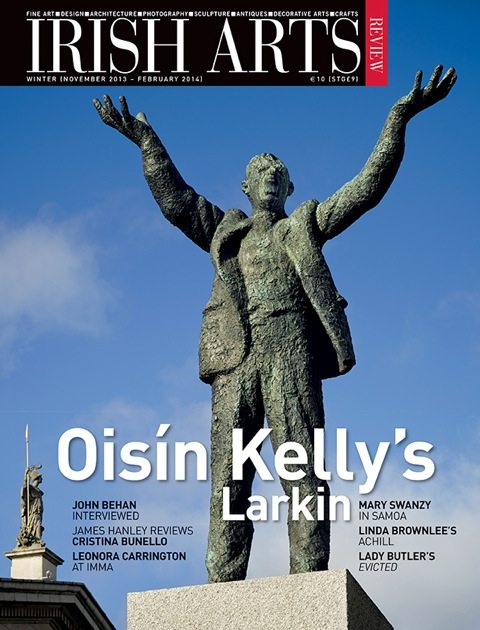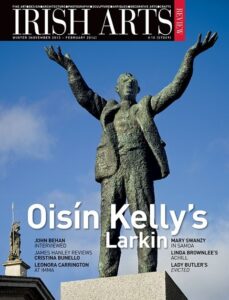

Brian Fallon recalls his first impression on meeting Mary Swanzy and her Gauguin moment conceived during a visit to Samoa
Mary Swanzy is a maverick but major figure in Irish art, one who resists labelling or categorizing, and on whom, so far, no really adequate body of critical opinion or biographical data exists. There are, no doubt, sound theses and academic records, either complete or in preparation, but there is no full-scale, biographical study that I know of – and this in the case of a fascinating and outstandingly gifted woman whose life and work urgently demand it. Well-meaning feminists may try to interpret her in terms of their personal orthodoxy, but while this may have its own validity, for the average art-lover it is likely to prove simplistic or partisan. Swanzy certainly typified the ‘enlightened’ woman of her generation, yet somehow she remained a loner and an individualist, both in life and art, who defies all generalizations.
I had the considerable privilege of knowing Swanzy personally, though she was at that stage an old woman while I was in my late thirties. By then she was a legend, though mainly among a generation of artists and collectors who were older than I and could track her career after a fashion (most younger people were scarcely aware of her at all). For instance, I remember Maurice MacGonigal saying she was the best living Irish painter, but that she had been living in London for years and as a result had been almost forgotten at home. I knew, vaguely, that she had been involved in the founding of the Irish Exhibition of Living Art, but then, what good woman painter of her generation had not ? Occasional works turning up at auctions did not give many clues, since they tended to be in contrasting styles which merely suggested that Swanzy had been over-influenced by a number of schools and movements, including Cubo-Futurism.
Then, in 1968, came the retrospective exhibition at what is now the Hugh Lane Gallery – not a very large one and, as I recall, rather patchy or uneven, but it helped to break the ice and bring her name again before the public. I reviewed it for The Irish Times, a review I have not kept but it brought an appreciative letter from her – which I still possess. A little later, Leo Smith of the Dawson Gallery took her up and there were at least two exhibitions there. It was just before the opening of the first of these that I was introduced to her, and though I was inhibited by her outwardly rather grande-dame, patrician manner, I found that she was in fact approachable and even friendly (various other people, however, found her formidable). As a result, I was able to organize interviews and a little publicity in my newspaper, which I think helped to alert Dublin art circles to the fact that a major figure had survived and was among them. I met her a number of times after that but never visited her at her home in London (where she lived with her sister), nor did I correspond with her – both of which lapses I bitterly regret.
What dominates these Samoan pictures is, almost inevitably, the light of the tropics – in this case, not a harsh or daunting glare but a warm, even luminosity which permeates them almost like some fluid substance
However, I am not writing personal memoirs, merely making some tentative attempt to ‘place’ her as a painter. I do believe, more and more, that she is a unique figure in Irish art and quite possibly the finest woman painter we have produced; I also admit I am still puzzled, and even frustrated, by the seeming lack of continuity in her career, and the clash of styles. Though from the start a very competent technician, she seems to have gone through a variety of contrasting phases which are hard to add up into a coherent unit. The Samoan works I am considering here, which date mostly from 1919-1925, are a remarkable chapter in her long life, but not a conclusive one and she did not find her final, wholly original phase by way of them. Possibly they were, among other things, a gesture of independence at a time when upper-class women – including painters – were still expected to conform to canons of respectability and not go unchaperoned among so-called savages wearing loin-cloths and little else. They were also indebted to Gauguin, who was relatively little known in England (or Ireland, for that matter) before the First World War but became a cult figure in the1920s, when the full impact of Post-Modernism was felt and Gauguin’s one-time friend and housemate, van Gogh, received a kind of posthumous canonization.
It was a period in which would-be bohemians and ‘emancipated’ people liked to taste the primitive life, like Augustus John with his gypsy caravan or the many London art-college products who lived for a time as voluntary peasants at remote villages in France or Italy, even Spain. Gauguin was seen as a symbol of the artist who had rejected urban civilization so that he could live, and paint, close to nature and to Natural Man (not to mention, in his case, Natural Woman). The South Sea Islands were in fact no unspoilt Eden, they were exploited without scruple by traders and commercial adventurers, increasingly prone to the white man’s diseases (including syphilis) and proselytized by sometimes ignorant and dogmatic missionaries. Nevertheless, though Gauguin died miserable and alone on Tahiti, he did create great art with a wholly novel, exotic vocabulary and blazed a trail of sorts for like-minded artists to follow.
she was an imaginative and expressive artist with a tendency towards fantasy, poetry and even black humour, laced with an odd and very personal kind of symbolism
What dominates these Samoan pictures is, almost inevitably, the light of the tropics – in this case, not a harsh or daunting glare but a warm, even luminosity which permeates them almost like some fluid substance (Figs 7,8&9). Unlike Gauguin, Swanzy did not transpose or heighten her colours – not obviously, at least – and her general approach is realist more than expressionist (compare them with Nolde’s South Seas paintings, done on the eve of the First World War; his seem positively garish in comparison). Nevertheless she achieved some notable harmonies, not only with the rich vegetation but also in her depictions of island women with their bright-coloured garments, softly brown limbs and (to us at least) asymmetrical faces. She not only painted the indigenous islanders she drew them over and over again, men and women alike (and children too ), whether sitting, standing or (more rarely) squatting. These islanders look sturdy if rather short in stature, quite unself-conscious, and seemingly at peace with themselves. The smoothly rounded arms of the women, above all, were readymade for a painter to exploit, and her modelling of these is full and sculptural. She seems to have filled entire notebooks with impromptu studies, in pencil or other media – I have, in fact, seen and handled one of these, illustrating her sheer professionalism and application (Figs 3,4&13). While Swanzy was never a straightforward ‘academic’ artist, neither at this stage was she an innovator, or even a Modernist, in any deeper sense. Her training had been largely traditionalist – though also cosmopolitan – and in the South Seas she stuck largely to what she saw, though with a certain, Post-Impressionist flattening of volumes. At the moment it has become fashionable, indeed almost obligatory, to hail her as one of the first Irish Cubists, or perhaps Cubo-Futurist would be a more accurate term (Fig 11). In a sense the description is fully deserved, but it only takes us so far in defining or understanding her very individual mentality. Cubism, when she came to it, was a style widely diffused among mildly advanced painters striving to get away from an academic training; it had become virtually a new salon art, very unlike the vibrant, revolutionary works which Braque and Picasso had created more than a decade before. Much the same was true of Futurism, which had grown tame and conventionalized compared with the almost daemonic power and originality of Boccioni’s work.
Swanzy’s Cubo-Futurist phase does not, in my own opinion, represent her best or most typical aspect. She mastered it fully as a style, but in a curiously impersonal way, without real inner life or vibration. The great, original Swanzy is surely in her late work – which, only too predictably, commentators have viewed as a backsliding into traditionalism. As I see it at least, Swanzy was never at heart a ‘formal’ painter, instead she was an imaginative and expressive artist with a tendency towards fantasy, poetry and even black humour, laced with an odd and very personal kind of symbolism. Her late style incorporates the influence of artists as diverse as Rouault, Goya, Chagall, Jack Yeats, Daumier, perhaps even the Surrealists; and instead of the lucid tones of the French School, we get something closer to chiaroscuro and the Romantics. Swanzy is, in fact, a very strange painter, one who stands quite alone, and it may well take critics and art historians some decades yet to sort her out. Meanwhile, why not a ‘Swanzy Room’ in one of our public galleries, and perhaps a handsome postage stamp as well to commemorate her?
All images ©The Artist’s Estate with permission.
Brian Fallon is the author of An Age of Innocence: Irish Culture 1930-1969.
From the IAR Archive
First published in the Irish Arts Review Vol 30, No 4, 2013



